Knitting a blanket is one of the most rewarding and cozy projects you can take on. Whether you’re a beginner or have some knitting experience, making your own blanket is both fun and fulfilling.
The best part? You don’t have to spend a lot of money buying patterns. There are many free and easy knit blanket patterns available online, so you can start a new project without breaking the bank.
In this blog, I’ll share the best easy-to-follow and free knitting patterns for blankets. These patterns are perfect for beginners and offer different styles, from simple garter stitch blankets to more textured designs. If you’re making a throw for your couch or a full-sized bed blanket, there’s a free pattern here for you.
Why You Should Knit Your Own Blanket

Knitting your own blanket comes with many rewards. It is a relaxing and enjoyable activity that also offers a sense of accomplishment. Some benefits of knitting your own blanket are:
1. Customization: You can choose the yarn, color, and size that fits your style.
2. Cost-Effective: Making your own blanket can be more affordable than buying one from a store.
3. Personal Touch: A handmade blanket is more meaningful and special, whether it’s for you or a gift.
4. Relaxing: Knitting is a calming and mindful activity that can help reduce stress.
5. Satisfaction: Completing a blanket gives you a sense of pride and accomplishment as you enjoy your cozy creation.
Knitting your blanket is a fun, rewarding process. It’s an opportunity to express creativity while making something functional and personal. Whether for yourself or as a gift, a handmade blanket is always special.
Choosing the Right Yarn for Your Knit Blanket & Other Materials
Before you start knitting your blanket, one of the most important decisions is choosing the right yarn. The yarn you select will affect the texture, warmth, and overall feel of your finished blanket.
- Weight: For most blankets, a worsted-weight yarn (medium weight) is ideal because it creates a nice balance between thickness and drape. However, for a lighter throw or summer blanket, you can use sport-weight yarn.
- Fiber: Wool is warm and cozy, but for an allergy-friendly option, acrylic yarn works well. Cotton yarn is also a good choice if you want something breathable and easy to wash.
- Softness: If you’re knitting a blanket to cuddle up with, make sure you pick a yarn that feels soft against your skin. Choose plush yarn for an extra cozy feel.
Other Materials
- Needles: Use US size 8-10 (5-6 mm) needles for worsted weight yarn or larger needles for bulky yarn.
- Stitch Markers: Help keep track of your pattern and row beginnings.
- Tapestry Needle: For weaving in the ends once your blanket is complete.
- Scissors: To cut the yarn when switching colors or finishing the project.
- Measuring Tape: To ensure your blanket reaches the desired size.
These materials will help you get started and keep your project organized as you knit your cozy blanket!
Easy and Creative Blanket Knitting Patterns
1. Garter Stitch Blanket
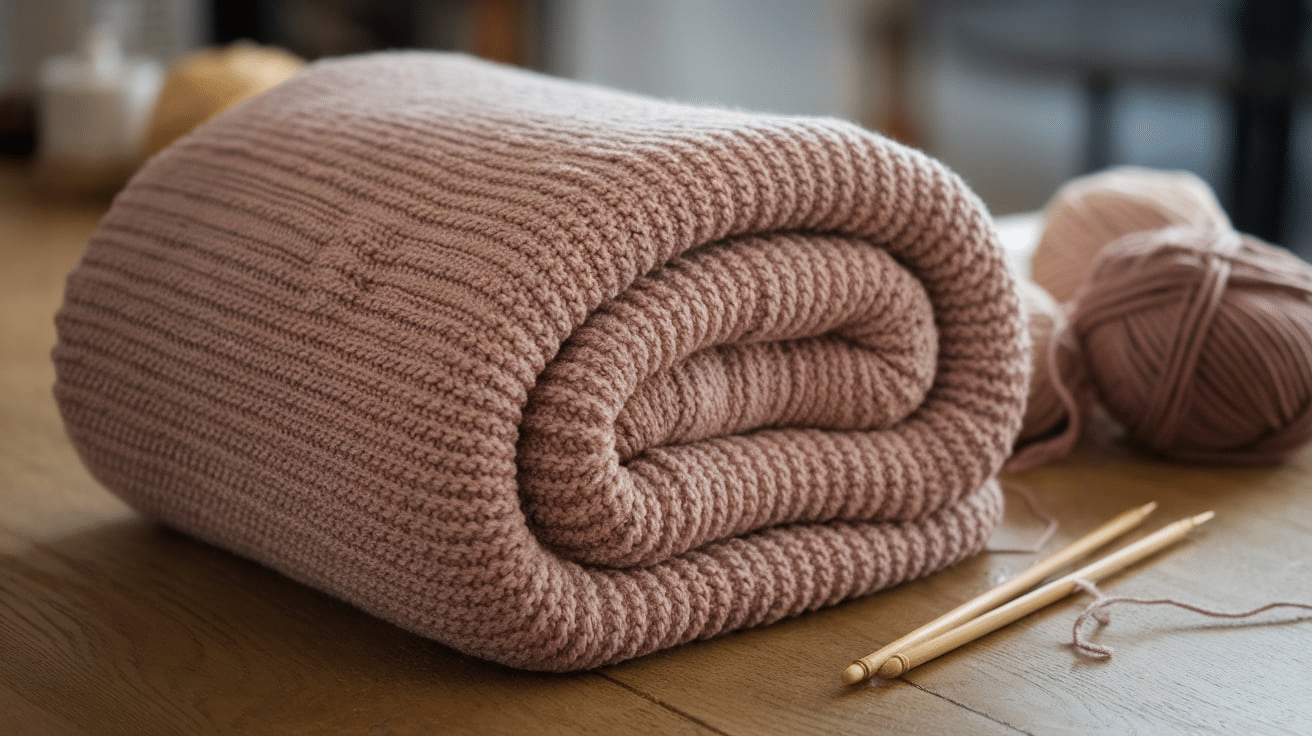
The garter stitch is a great option for beginners. It uses just one stitch, the knit stitch, and is easy to memorize. This pattern results in a squishy, stretchy fabric that’s perfect for cozy blankets.
Pattern Details
- Cast-on: 100 stitches (or more, depending on your desired width).
- Instructions: Knit every row until the blanket reaches your desired length.
- Ideal For: Beginners who want a simple, no-fuss blanket that is fun to knit.
- Why It Works: The garter stitch creates a smooth, soft fabric, and it’s easy to knit up quickly.
The garter stitch blanket is perfect for anyone who wants to start a simple project without worrying about complicated patterns. It’s a great choice for a first-time knit blanket.
2. Basketweave Knit Blanket
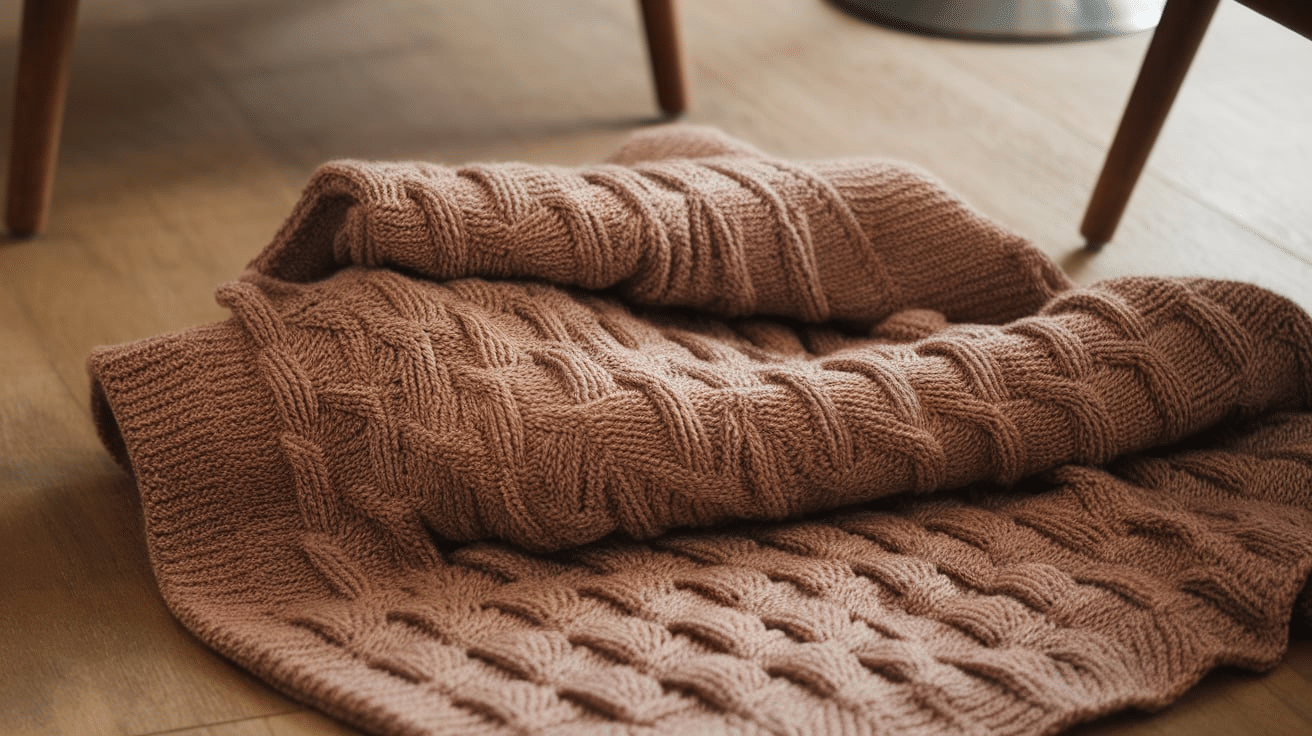
Basketweave stitch adds a lot of texture to your project. This stitch creates a woven effect, making it a great choice for a thicker, cozier blanket.
Pattern Details
- Cast-on: 120 stitches.
- Instructions: Alternate between knitting 4 stitches and purling 4 stitches, repeating this pattern across the row. After 4 rows, switch the pattern to create the basketweave effect.
- Ideal For: Those who want a textured, patterned blanket but are still beginner-friendly.
- Why It Works: This stitch creates a dense, warm blanket with a beautiful textured design.
The basketweave knit blanket pattern is a great way to practice your knitting and purling skills while creating a warm, textured throw.
3. Stripe Knit Blanket
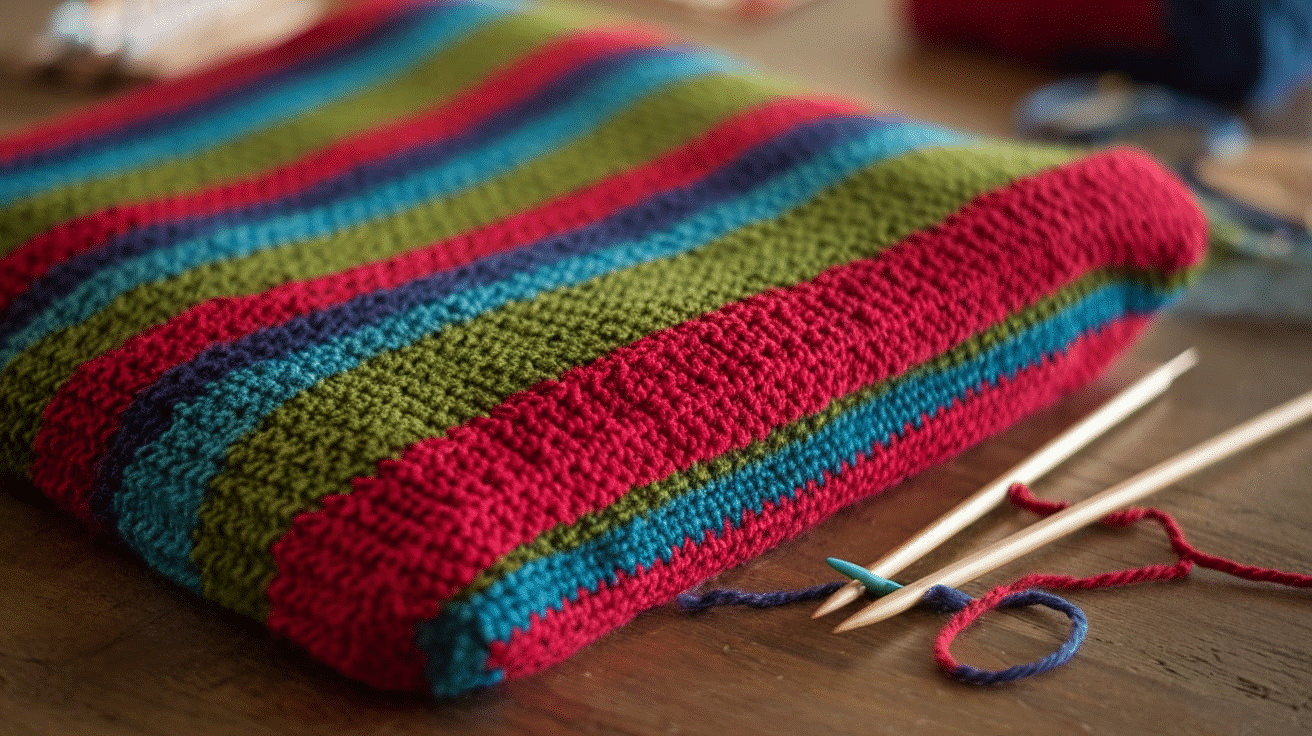
Stripes are a simple way to add color and visual interest to your blanket. By using multiple colors of yarn, you can create stripes of any width to customize your blanket.
Pattern Details
- Cast-on: 90 stitches.
- Instructions: Knit the blanket in a garter stitch, alternating between your chosen colors every 10 rows. Make sure to carry the yarns at the edges so they don’t tangle.
- Ideal For: Knitters who want to add a bit of color to their project without too much complexity.
- Why It Works: Simple, colorful stripes are an easy way to make your blanket pop, and you can mix and match as many colors as you like.
A striped blanket is an excellent way to show off your favorite yarn colors and create a cheerful, lively piece for your home.
4. Super Chunky Knit Blanket
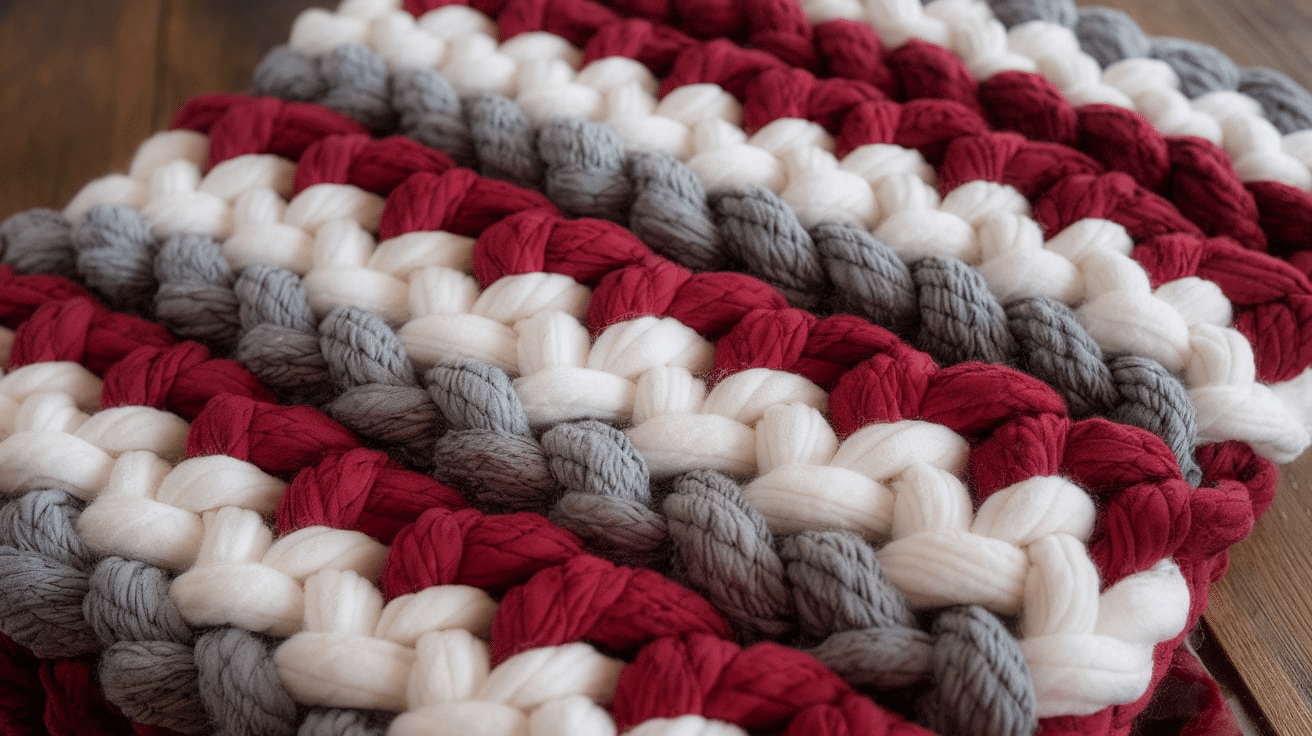
Super chunky yarn is a popular choice for fast, warm projects. With super bulky yarn, you can knit a cozy blanket quickly, making it a great option for last-minute gifts or projects.
Pattern Details
- Cast-on: 60 stitches.
- Instructions: Use a super chunky yarn and a large needle to knit every row in the garter stitch. This blanket will grow quickly and provide a nice, thick fabric.
- Ideal For: Anyone looking for a super cozy and fast project.
- Why It Works: The large stitches and thick yarn give the blanket a soft, squishy feel, and it comes together quickly.
If you’re looking for a speedy project, a super chunky knit blanket is perfect. The big yarn and thick needles create a quick, cozy masterpiece.
5. Cable Knit Blanket
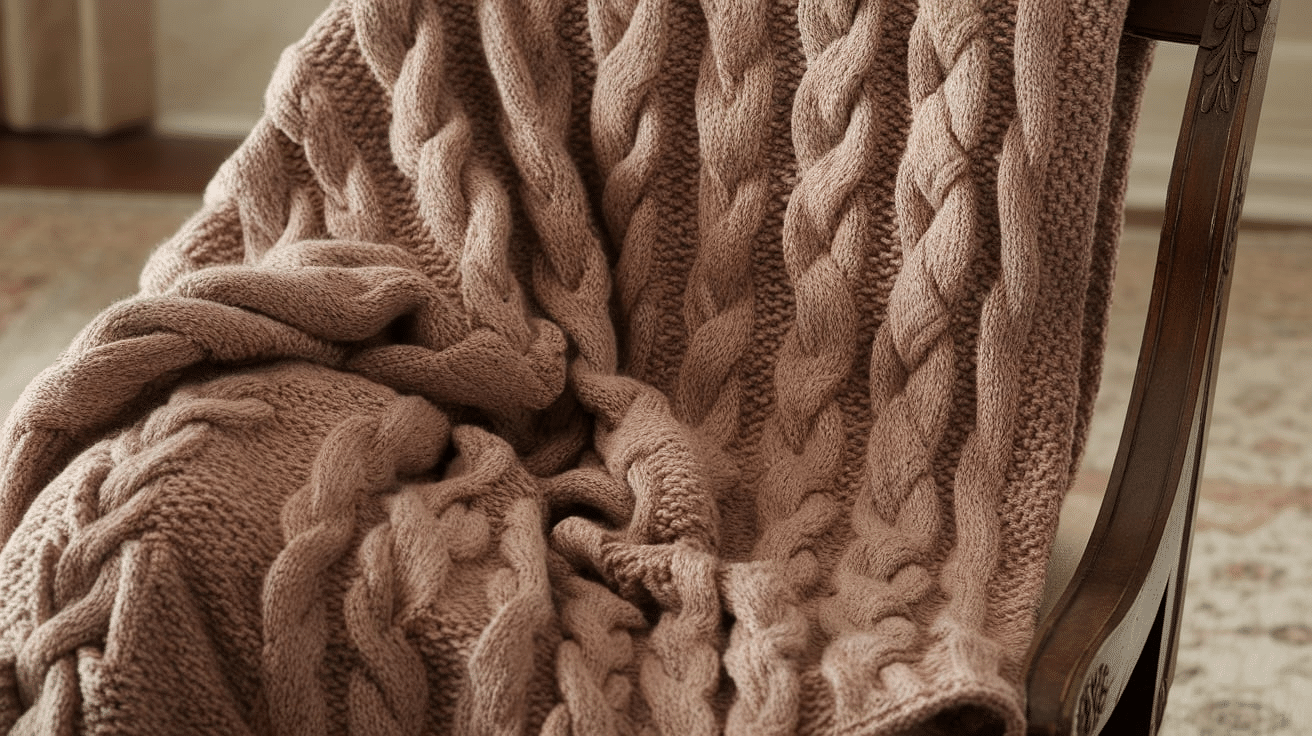
For those who want to try something a bit more advanced, cable knitting adds a beautiful, intricate design to any blanket. This pattern features twisting cables that form woven patterns across the fabric.
Pattern Details
- Cast-on: 120 stitches.
- Instructions: Work in a combination of knit and purl stitches to create the cable patterns. You will need a cable needle to complete the twists.
- Ideal For: Experienced knitters looking to add a textured and elegant design to their blanket.
- Why It Works: Cables create a lovely, detailed texture that is perfect for blankets that you want to have a luxurious feel.
A cable-knit blanket is perfect for knitters who want to add some sophistication and elegance to their blanket designs. It’s a great way to show off your knitting skills.
6. Waffle Knit Blanket
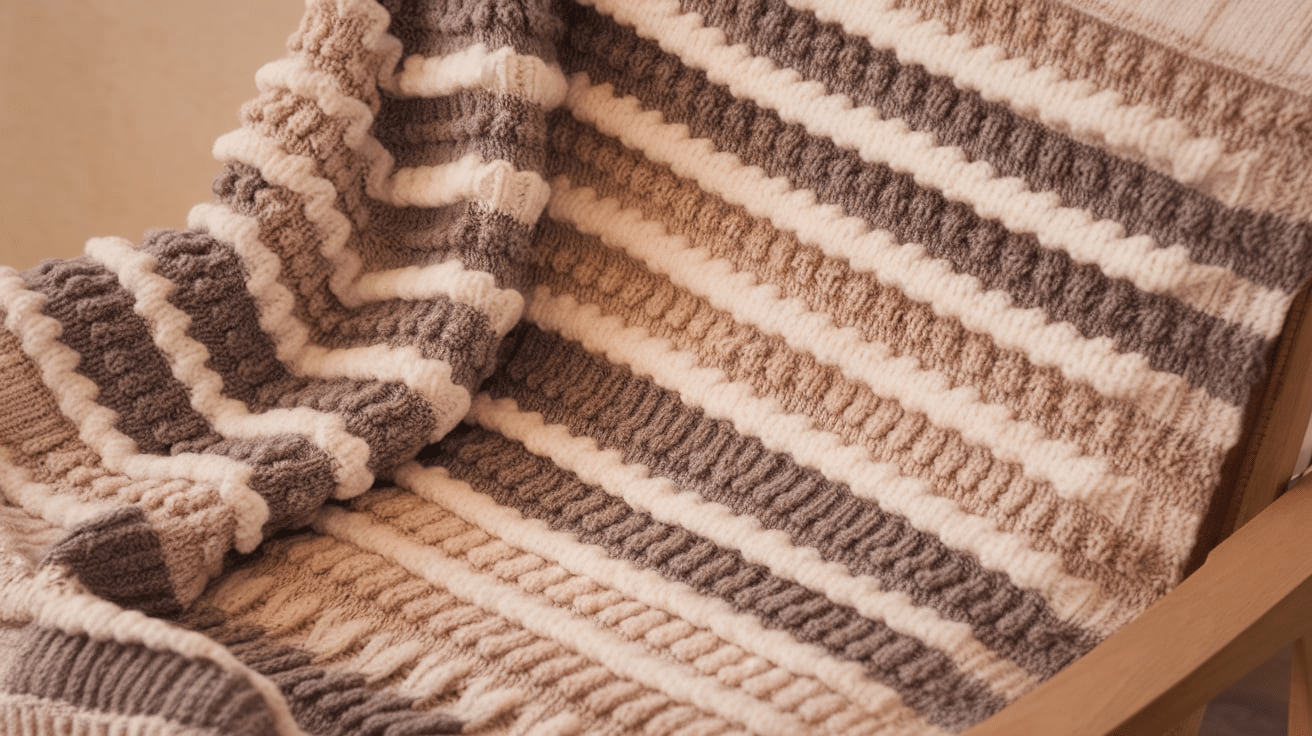
The waffle stitch creates a textured, cozy fabric that resembles a waffle’s pattern. It’s another great option for creating a thick, squishy blanket.
Pattern Details
- Cast-on: 110 stitches.
- Instructions: To create the textured waffle pattern, knit in a combination of knit and purl stitches. Each row alternates between knit and purl in a set of four stitches.
- Ideal For: Those looking to add texture without the complexity of cables.
- Why It Works: The waffle stitch creates a dense, plush fabric that’s perfect for blankets.
A waffle-knit blanket is cozy, textured, and easy to knit up. It’s a perfect choice for a comfy, everyday blanket.
7. Simple Stockinette Stitch Blanket
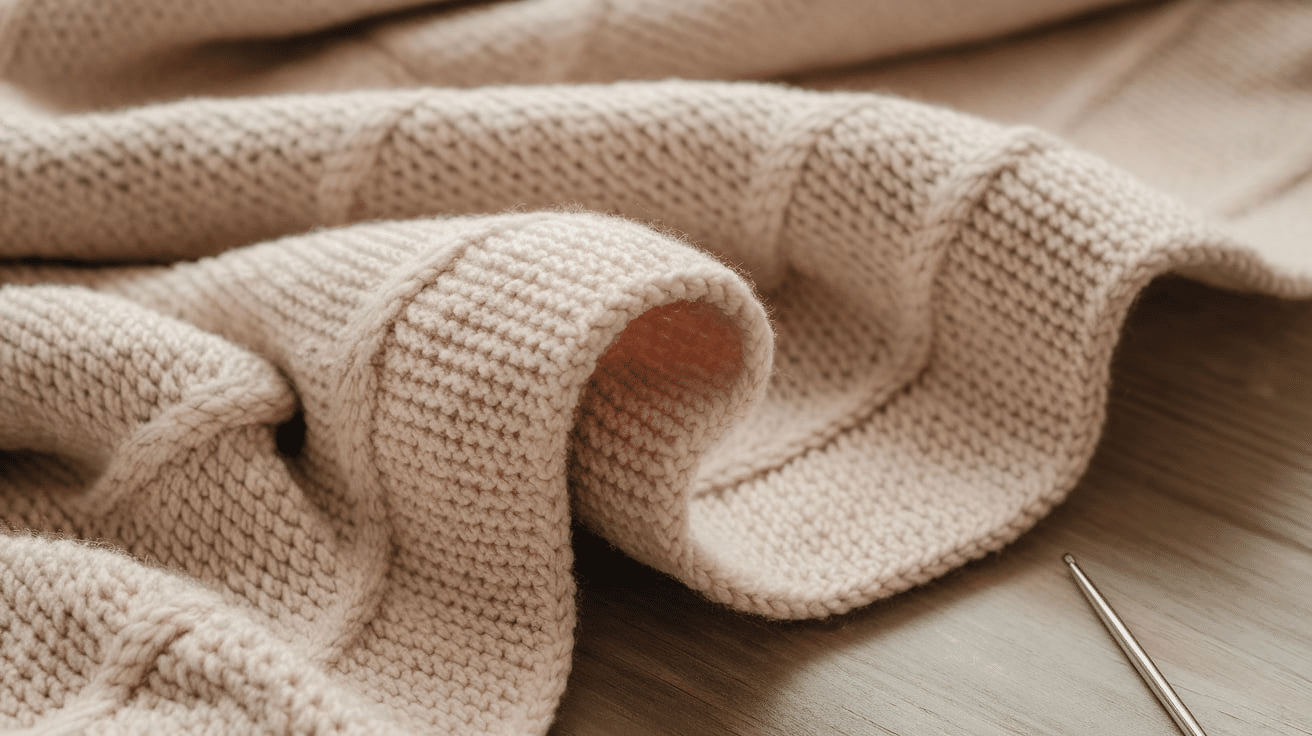
Stockinette stitch is a basic but popular stitch that creates a smooth fabric with a slight curl at the edges. This pattern is easy to knit and works well with various yarns.
Pattern Details
- Cast-on: 90 stitches.
- Instructions: Knit one row, then purl the next. Repeat until the blanket reaches your desired length.
- Ideal For: Beginners looking to practice stockinette stitch.
- Why It Works: It’s an easy pattern to follow, and the smooth fabric works well for a variety of yarns.
The stockinette stitch blanket is perfect for beginners who want to keep it simple while creating a soft, smooth fabric.
8. Ribbed Knit Blanket
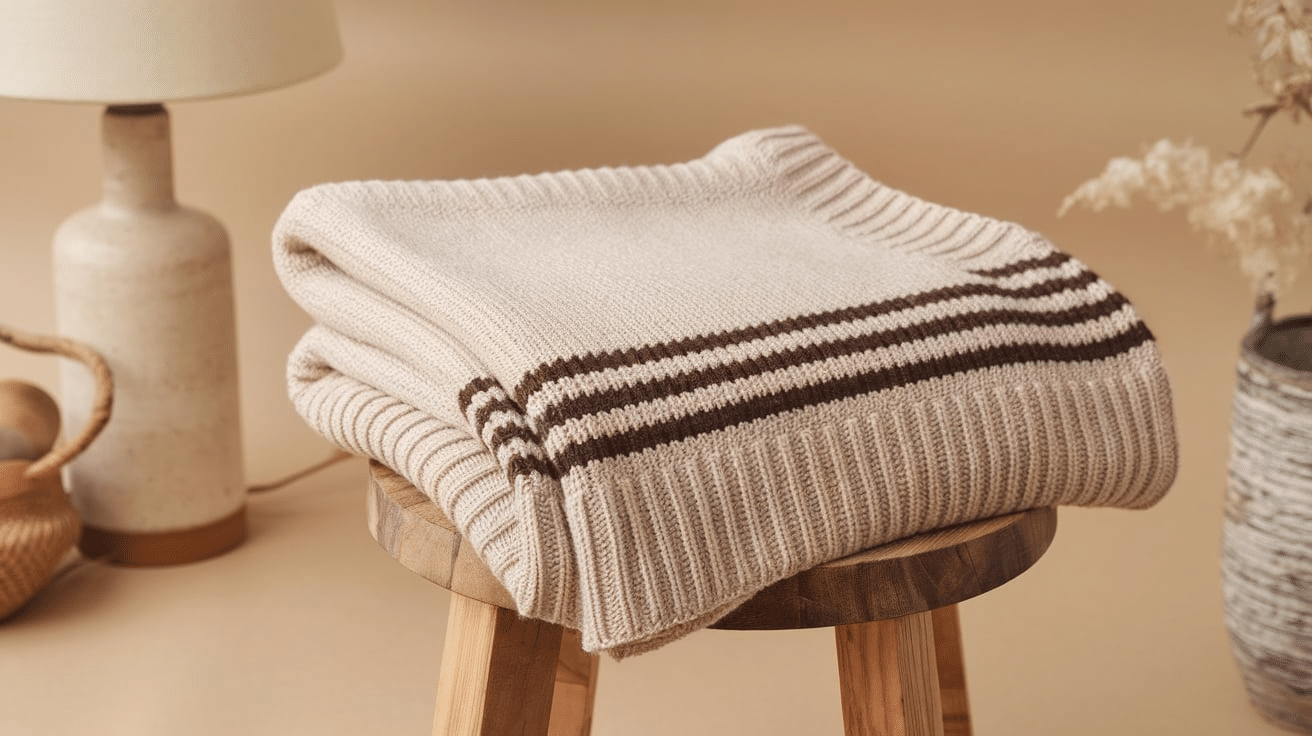
The ribbed stitch creates a stretchy, textured fabric that is both durable and cozy. This pattern is simple to follow and adds a nice, clean look to your blanket.
Pattern Details
- Cast-on: 120 stitches.
- Instructions: Work in alternating k1, p1 (knit 1, purl 1) pattern for each row.
- Ideal For: Knitters who want a stretchy, textured blanket that still has a simple, elegant design.
- Why It Works: Ribbing adds structure and elasticity, making the blanket more flexible and comfortable.
The ribbed knit blanket is a great option if you want a fabric that has a bit of stretch and texture but doesn’t require complicated techniques. It’s a perfect choice for blankets that need to hold up well over time.
9. Lace Knit Blanket
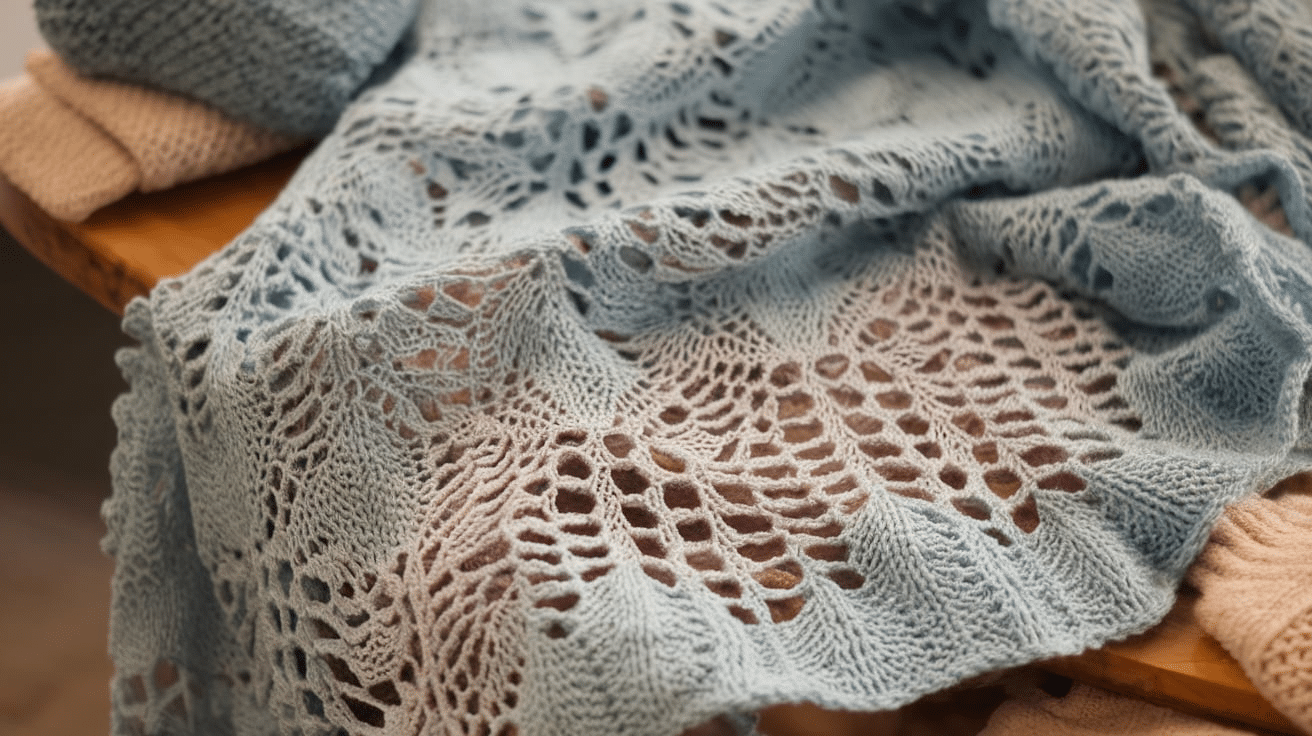
If you want to challenge yourself with a more intricate design, the lace pattern is a great way to go. It’s a beautiful, airy stitch that works well for lightweight blankets and shawls.
Pattern Details
- Cast-on: 120 stitches.
- Instructions: Follow a lace pattern (e.g., the feather and fan stitch) to create openwork designs. Lace patterns typically involve yarn overs and decreases.
- Ideal For: Experienced knitters or those looking for a delicate and intricate design.
- Why It Works: Lace patterns create an elegant, open design perfect for lightweight, decorative blankets.
A lace-knit blanket is ideal for knitters who want to make a statement with their work. This delicate, airy design adds a touch of sophistication to any project.
10. Chevron Knit Blanket
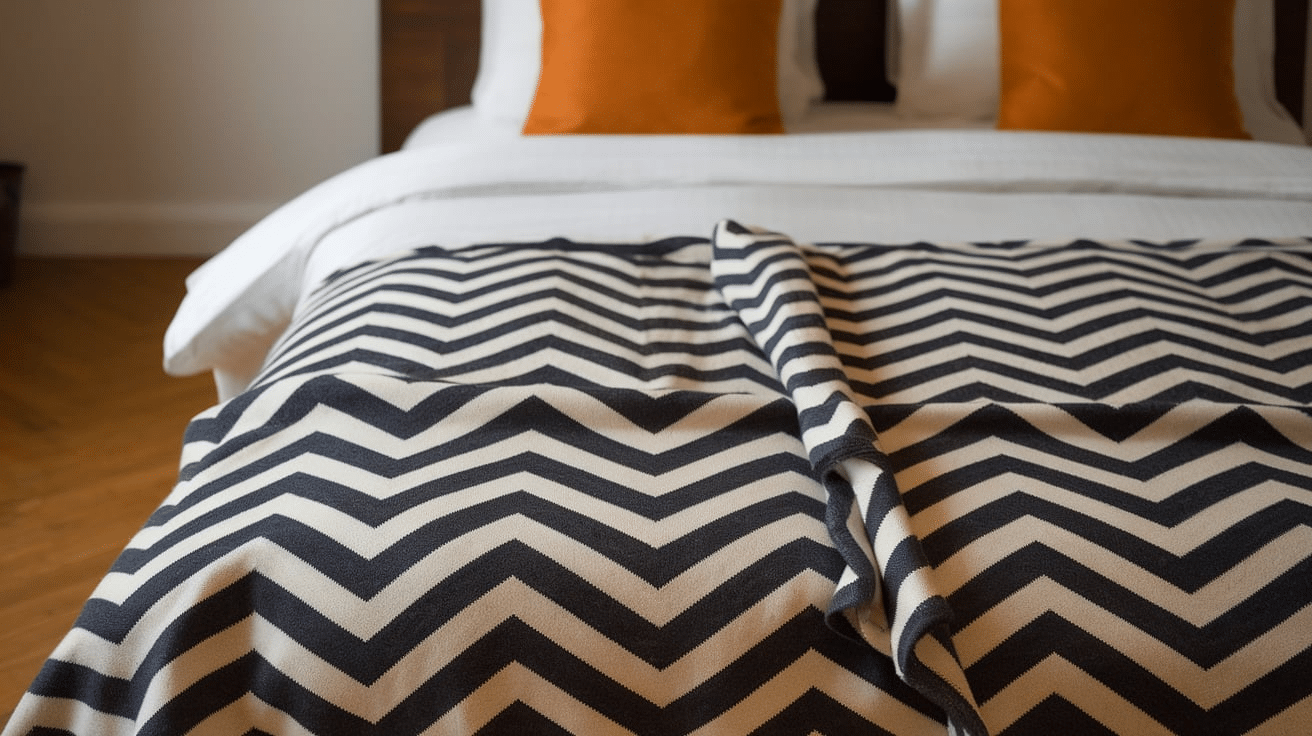
Chevron patterns are a fun way to add movement and interest to a blanket. This design uses increases and decreases to create zigzag patterns.
Pattern Details
- Cast-on: 110 stitches.
- Instructions: Alternate between increasing and decreasing stitches to create the chevron pattern, following a set of increases and decreases to shape the zigzags.
- Ideal For: Knitters who want to learn shaping techniques and create a fun, dynamic design.
- Why It Works: The chevron pattern adds depth and texture, making your blanket more visually interesting.
A chevron knit blanket is a fun and dynamic project, perfect for those who want to practice shaping stitches and create a blanket with lots of movement and personality.
11. Simple Chevron Stripes Blanket
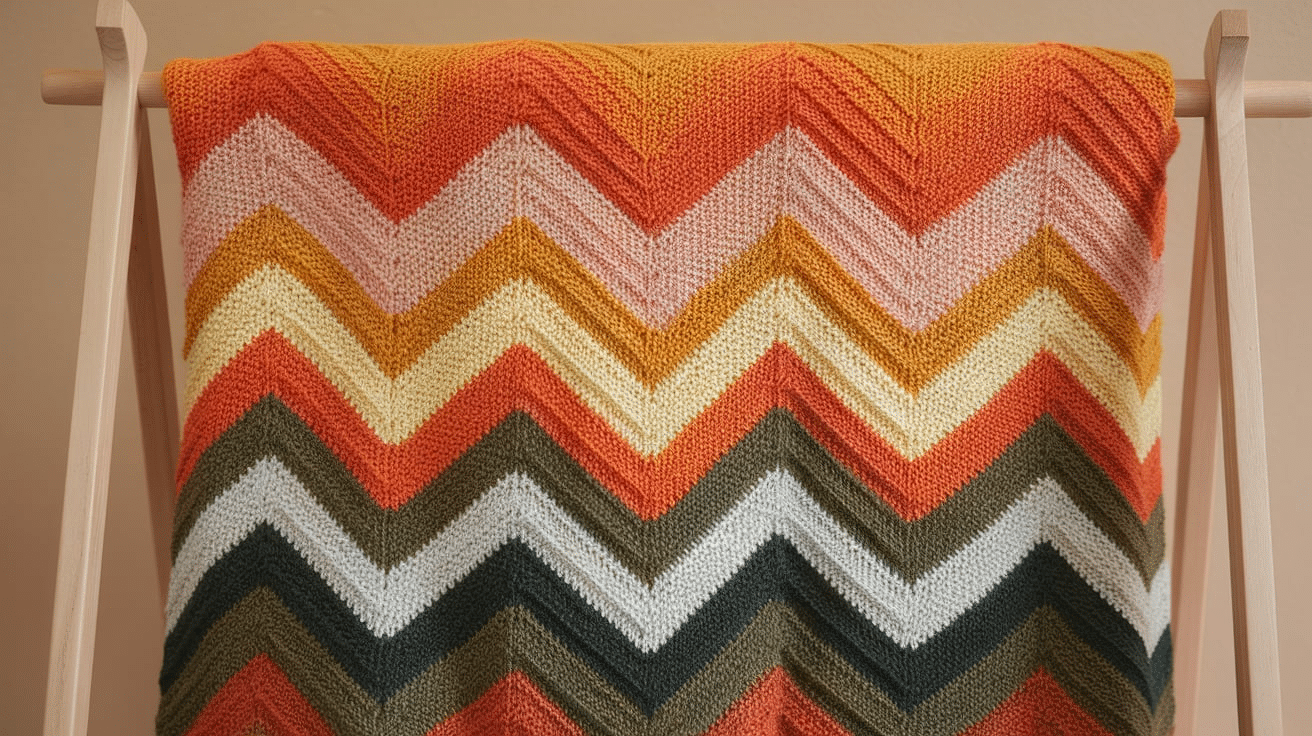
This simple chevron-striped blanket pattern is an easy way to create a colorful and cozy blanket without any complicated stitchwork. The design alternates between colored stripes and zigzag chevrons.
Pattern Details
- Cast-on: 120 stitches.
- Instructions: Work in a simple garter stitch, changing colors every few rows to create the chevron stripes. The chevron pattern is achieved by increasing and decreasing stitches.
- Ideal For: Beginners or anyone who wants to add stripes and texture to their blanket.
- Why It Works: This pattern is simple to follow, and the color changes give it a modern and playful look.
Chevron stripes are a simple but stylish way to create a colorful, fun blanket. The simple stitchwork and colorful design make it an enjoyable project for knitters of all levels.
12. Knit and Purl Blanket
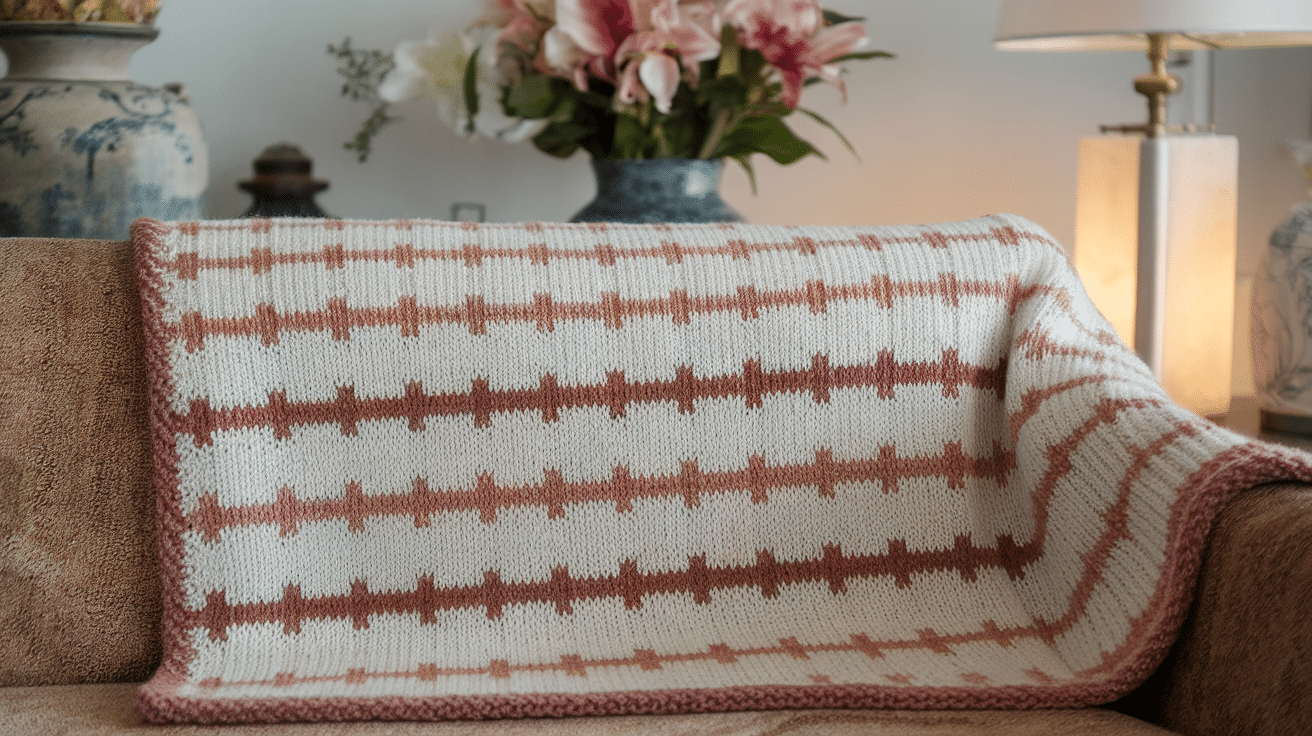
The knit-and-purl combination is one of the most versatile patterns for knitting. By alternating between knit and purl stitches, you can create different textures that give your blanket depth and interest.
Pattern Details
- Cast-on: 100 stitches.
- Instructions: Alternate between knit 1 and purl 1 across the row, repeating for the entire blanket. This creates a lovely, ribbed effect.
- Ideal For: Beginners who want to practice basic knitting and purling techniques.
- Why It Works: The alternating knit and purl stitches create a stretchy, soft fabric, perfect for blankets.
This simple yet effective pattern is perfect for beginners looking to create a soft, textured blanket with minimal effort. The knit and purl combination is classic and can be used for any blanket size.
13. Simple Colorblock Blanket
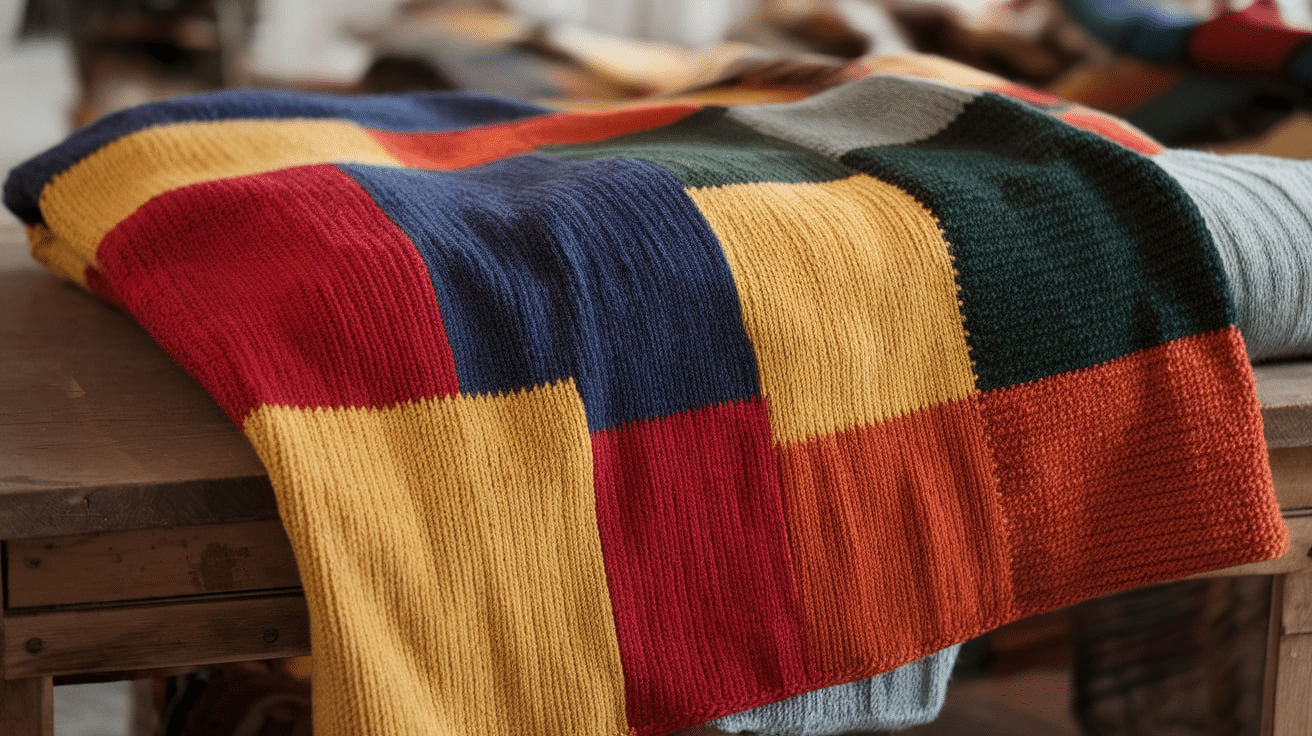
A color block blanket is an easy and stylish way to incorporate vibrant colors into your knitting. This pattern alternates blocks of solid color, creating a simple yet striking design.
Pattern Details
- Cast-on: 120 stitches.
- Instructions: Knit in garter stitch, changing colors every 20 rows (or more, depending on your preference) to form the blocks.
- Ideal For: Beginners who want to add some color and visual interest to their blanket.
- Why It Works: This pattern is easy to follow, and the color changes add a modern, stylish look to your project.
The color block blanket is perfect for those who love using bold, contrasting colors. It’s simple to knit but makes a big visual impact, and you can experiment with color combinations that suit your style.
14. Striped Garter Stitch Blanket
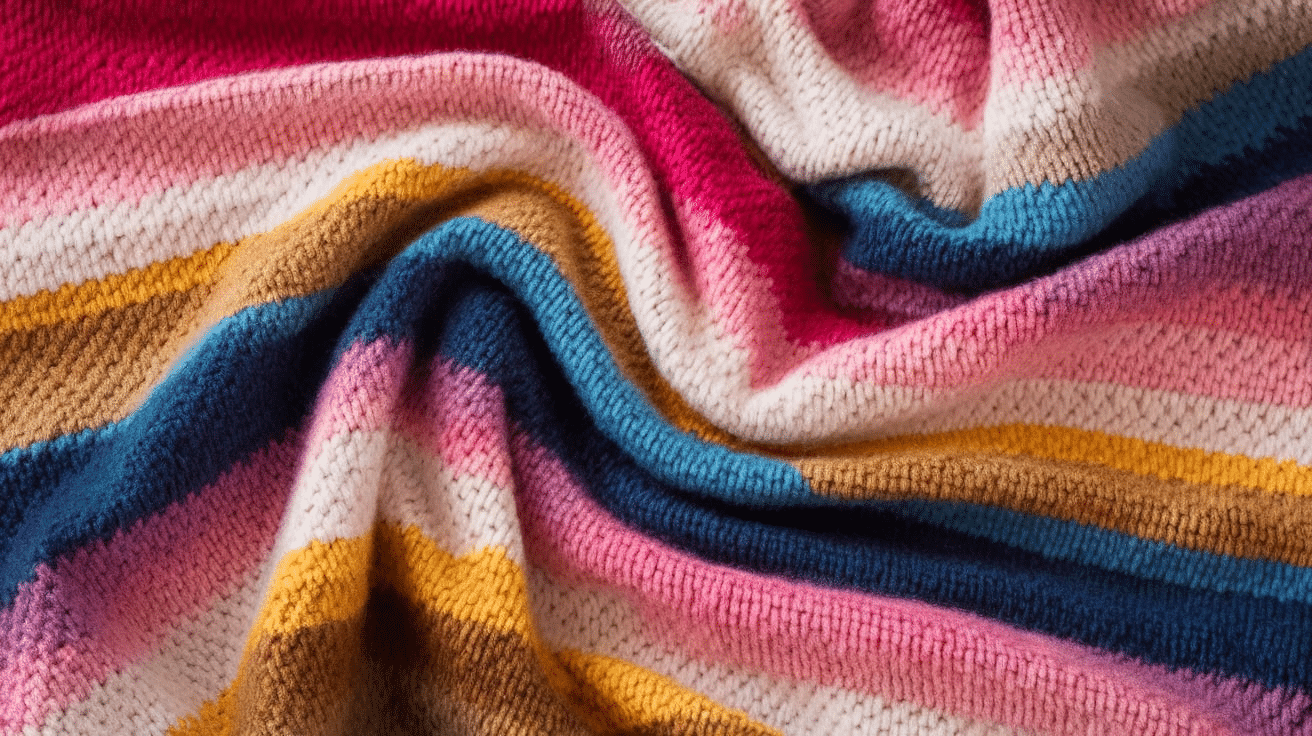
If you love the simplicity of garter stitch but want to add some color, a striped garter stitch blanket is a fantastic choice. This pattern alternates between solid color sections for a fun, playful look.
Pattern Details
- Cast-on: 100 stitches.
- Instructions: Knit every row in a garter stitch, switching between colors every 10-15 rows to create stripes.
- Ideal For: Beginners who want a simple yet colorful blanket.
- Why It Works: The garter stitch is easy to knit, and the stripes add a fun element to your blanket without complicating the process.
A striped garter stitch blanket is perfect for knitters who want a simple project with a pop of color. It’s easy to knit and can be customized with your favorite color combinations.
15. Garter Stitch and Lace Border Blanket
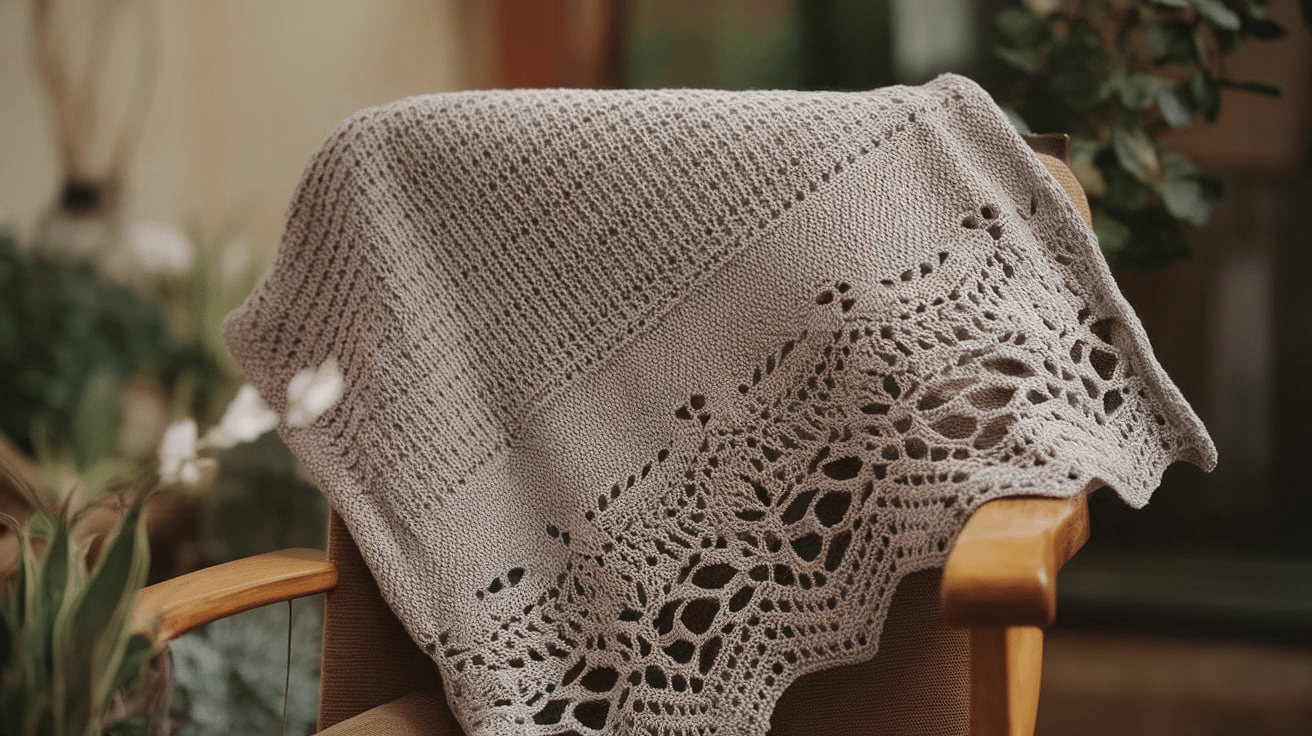
A combination of garter stitch and lace creates a simple yet elegant design. This pattern incorporates a lace border to elevate a basic garter stitch blanket.
Pattern Details
- Cast-on: 120 stitches.
- Instructions: Knit the main body of the blanket in garter stitch. Knit a lace pattern, such as the feather and fan stitch, around the edges to add a lace border.
- Ideal For: Knitters looking for an elegant and feminine touch to a simple blanket.
- Why It Works: The garter stitch keeps the blanket simple and fast, while the lace border adds sophistication.
This pattern is perfect for knitters who want to create a classic design with a touch of lace. It’s easy to knit and offers a delicate, refined finish.
16. Granny Stripe Knit Blanket
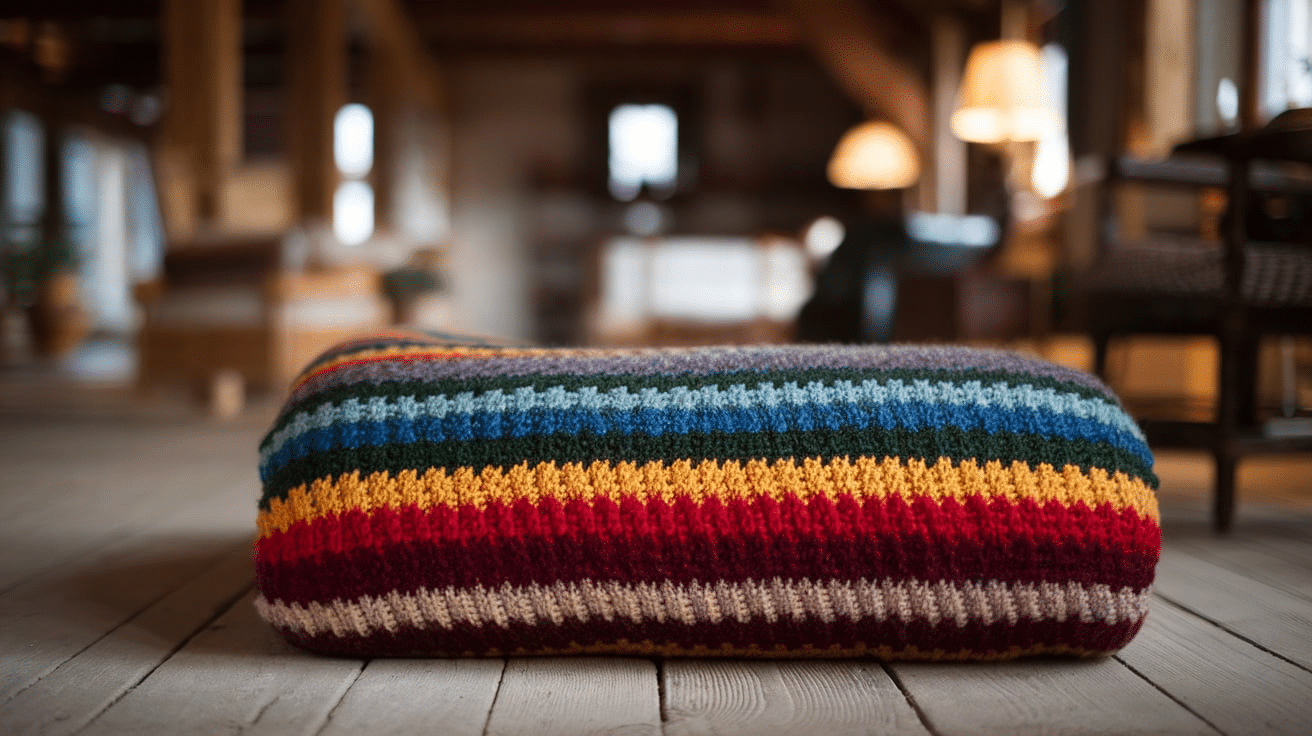
The granny stripe is a popular crochet technique, but it also works nicely with knitting. This pattern creates colorful stripes using short rows that resemble a granny square pattern.
Pattern Details
- Cast-on: 120 stitches.
- Instructions: Knit in garter stitch, using short rows to create the granny stripe effect. Alternate colors for each stripe.
- Ideal For: Knitters who want to incorporate fun, colorful stripes into their blankets.
- Why It Works: The short rows create a textured design, and the color changes keep things interesting.
A granny stripe blanket is a fun, colorful project that is perfect for those who want to use multiple colors in their knitting. The pattern is simple but results in a vibrant, cheerful blanket.
17. Plain Knit Blanket
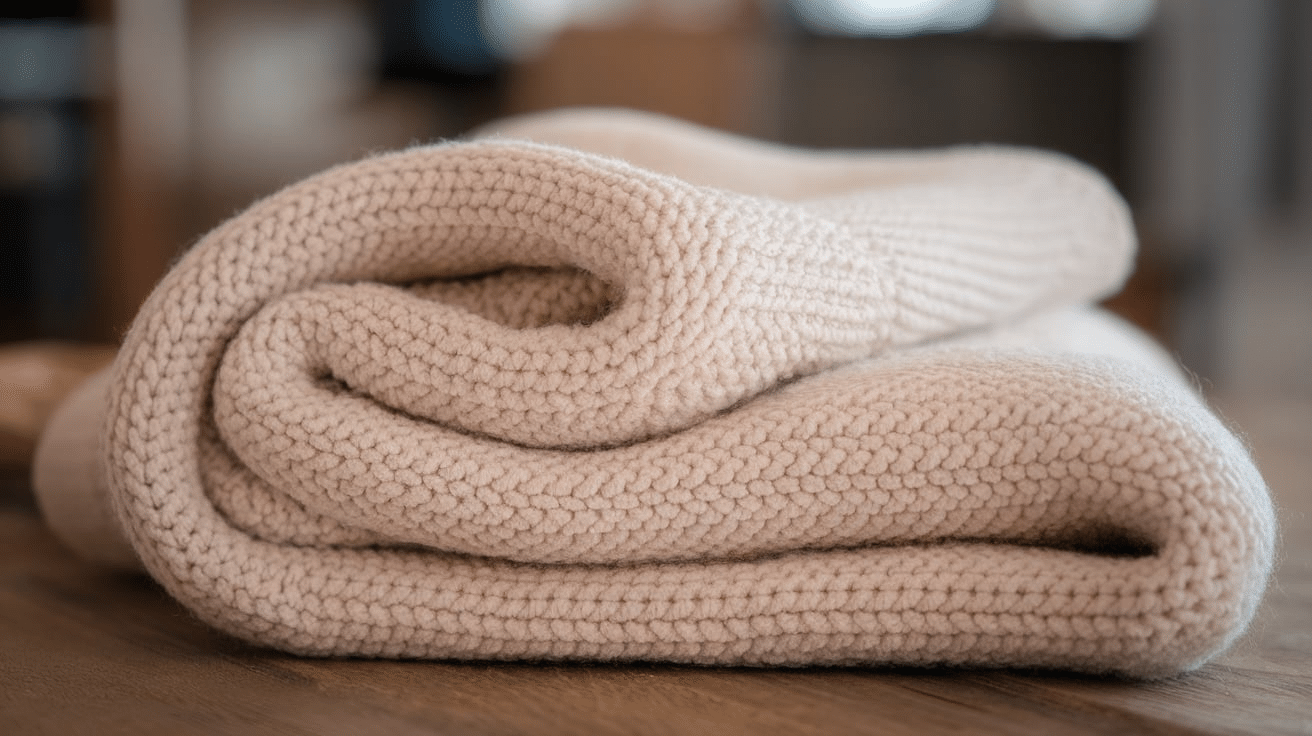
A plain knit blanket is one of the simplest patterns you can make. It’s perfect for beginners who want to practice their basic knitting skills. The smooth, even fabric it creates is beautiful in its simplicity.
Pattern Details
- Cast-on: 100 stitches.
- Instructions: Knit every row to create a plain knit fabric. You can use any yarn and needle size to adjust the blanket’s feel and texture.
- Ideal For: Beginners looking for a straightforward project.
- Why It Works: This pattern is simple, relaxing, and fast to knit, making it a great choice for beginners.
The plain knit blanket is perfect for those who want a no-fuss, quick project. It’s great for practicing your knit stitch, and you can always add borders or color for some fun extra flair.
18. Ribbed Edge Blanket
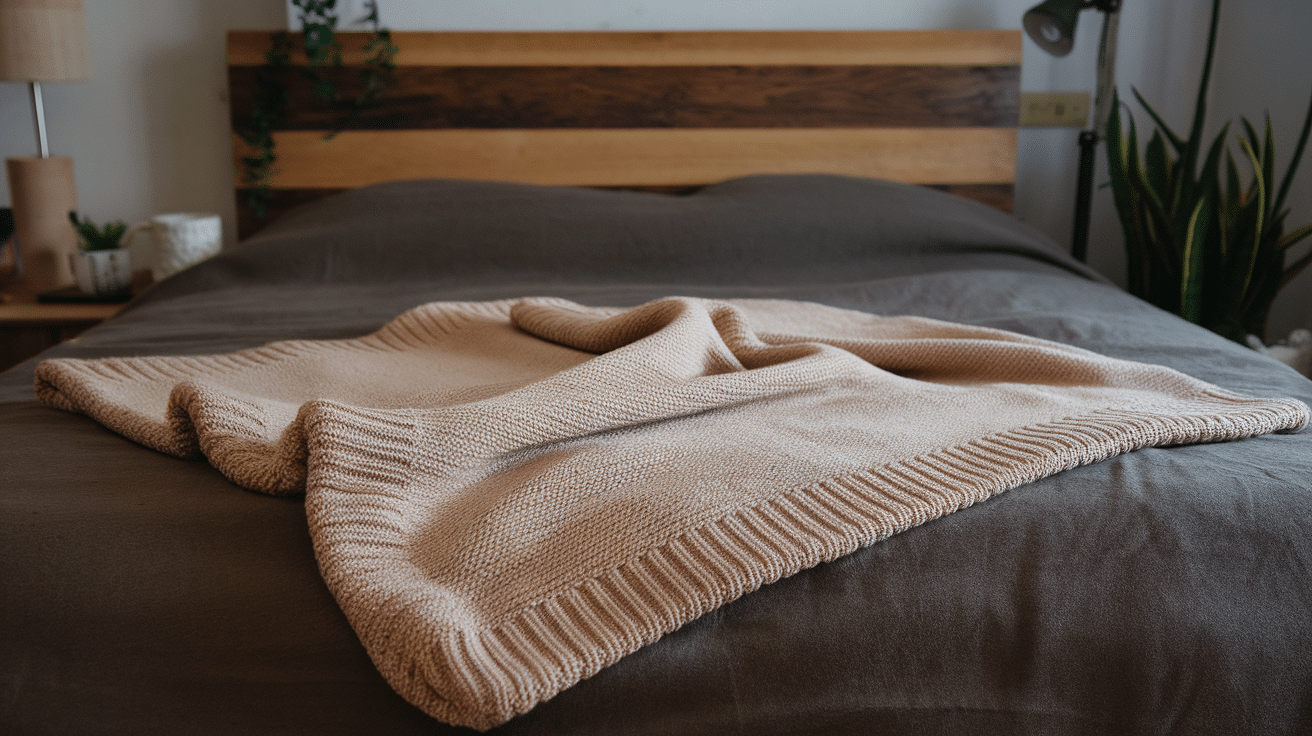
The ribbed edge blanket adds a bit of style and structure to a simple knit project. By adding ribbing to the edges, you can create a subtle, clean design that enhances the look of your blanket.
Pattern Details
- Cast-on: 120 stitches.
- Instructions: Knit the body of the blanket in garter stitch, but add a 4-stitch ribbed edge (k2, p2) at each end of every row.
- Ideal For: Those who want a clean, professional look with a bit of texture.
- Why It Works: The ribbed edges create a neat border, while the garter stitch body keeps the blanket soft and simple.
This pattern is ideal if you’re looking for a blanket with a polished finish. The ribbed edges provide a little extra detail, while the garter stitch body makes it cozy and easy to knit.
19. Mosaic Knit Blanket
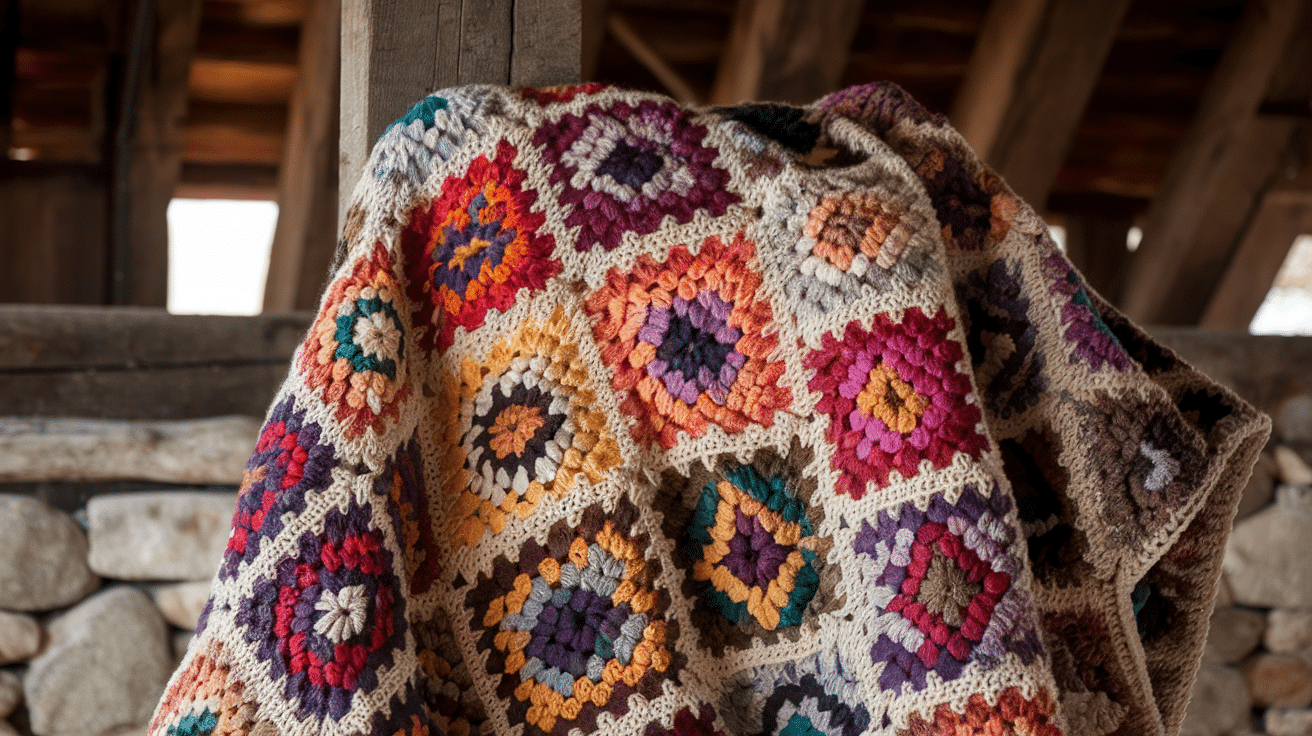
The mosaic stitch creates intricate, geometric patterns that resemble a woven design. This blanket pattern only uses colorwork, without complicated techniques like intarsia or fair isle.
Pattern Details
- Cast-on: 120 stitches.
- Instructions: Use two colors of yarn and follow a simple mosaic pattern that alternates colors every few rows.
- Ideal For: Knitters who want to try colorwork but don’t want to deal with complex techniques.
- Why It Works: The mosaic stitch creates beautiful, intricate patterns without requiring too many advanced skills.
Mosaic knitting is a great way to incorporate color into your blanket without getting overwhelmed by complicated techniques. This blanket will impress with its stunning geometric patterns!
20. Granny Square Knit Blanket
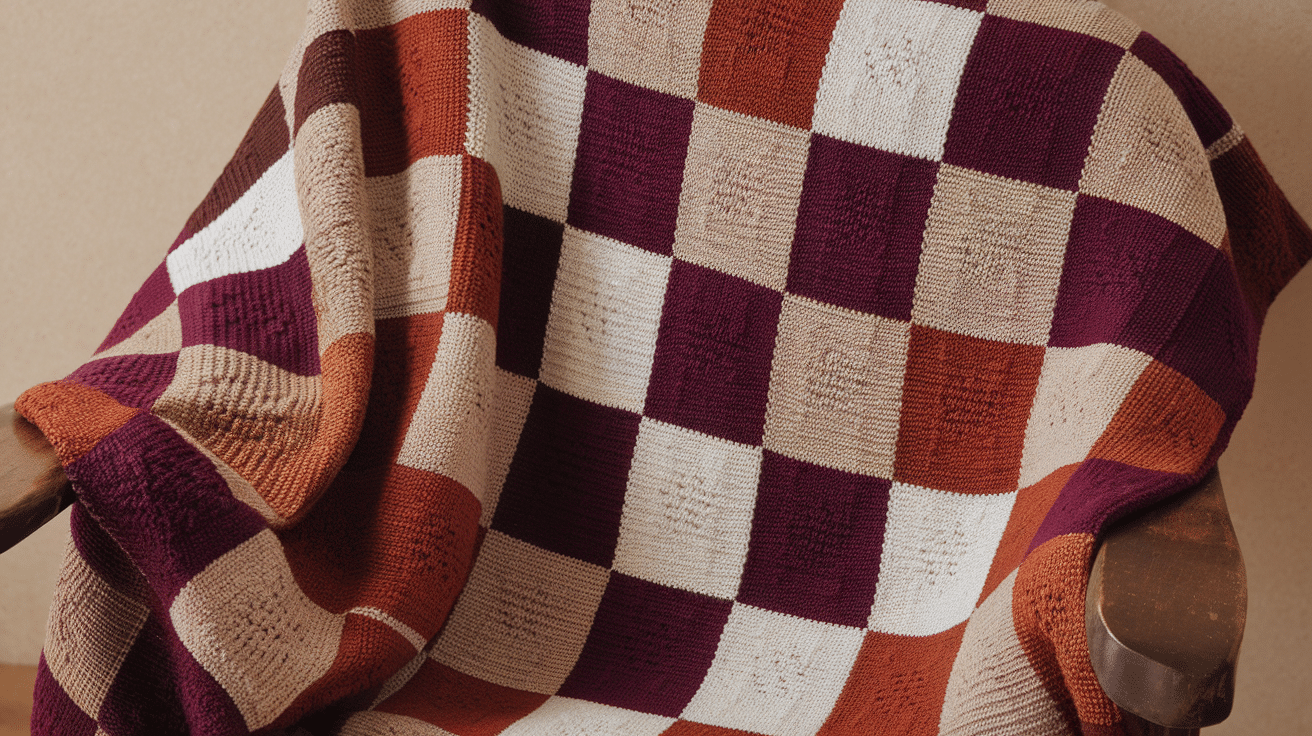
Granny squares are often associated with crochet, but you can create similar results with knitting! This granny square knit blanket uses knitted blocks to form the classic pattern.
Pattern Details
- Cast-on: Cast on for each individual square (typically 20 stitches).
- Instructions: Knit each square using a basic garter or stockinette stitch. Once the squares are done, sew them together to form the blanket.
- Ideal For: Knitters who want to try a block-style project.
- Why It Works: Knitting in squares is more portable and can be completed in sections, which is less overwhelming for some knitters.
A granny square knit blanket is a great way to practice knitting in blocks. It’s also a fun project that lets you play with colors and patterns, and it can be done in small sections for ease.
21. Cozy Knit Blanket with Fringe
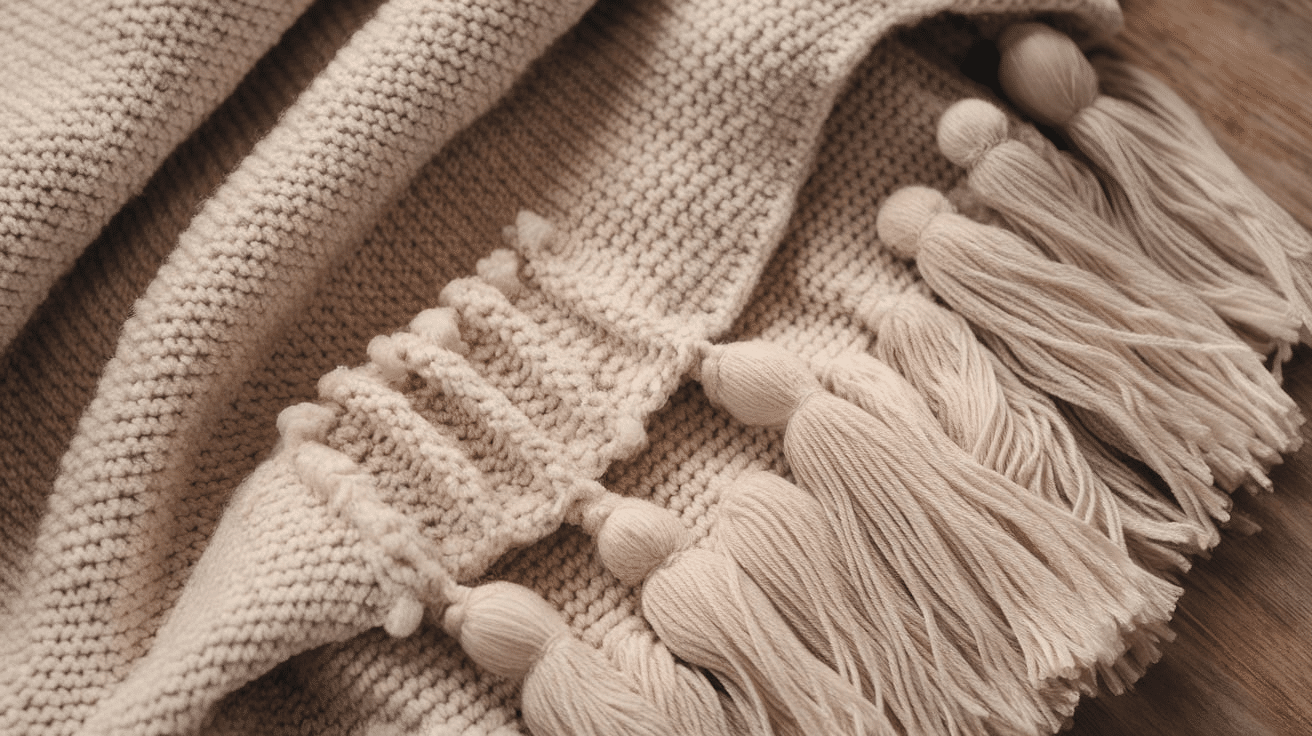
Adding fringe to a blanket gives it a boho and playful look. This cozy knit blanket with fringe combines soft yarn with a fringed edge for a fun, stylish blanket that’s both trendy and comfy.
Pattern Details
- Cast-on: 100 stitches.
- Instructions: Knit the entire blanket in a garter stitch or stockinette. Once the blanket is complete, create fringe using extra yarn and attach it to the edges.
- Ideal For: Knitters who want a fun, playful design.
- Why It Works: The fringe adds a unique touch that makes the blanket stand out while still being simple to knit.
A cozy blanket with fringe is a great way to add personality to a simple project. The fringe gives your blanket a trendy look without complicating the knitting process.
22. Plain Knit Throw with Cables
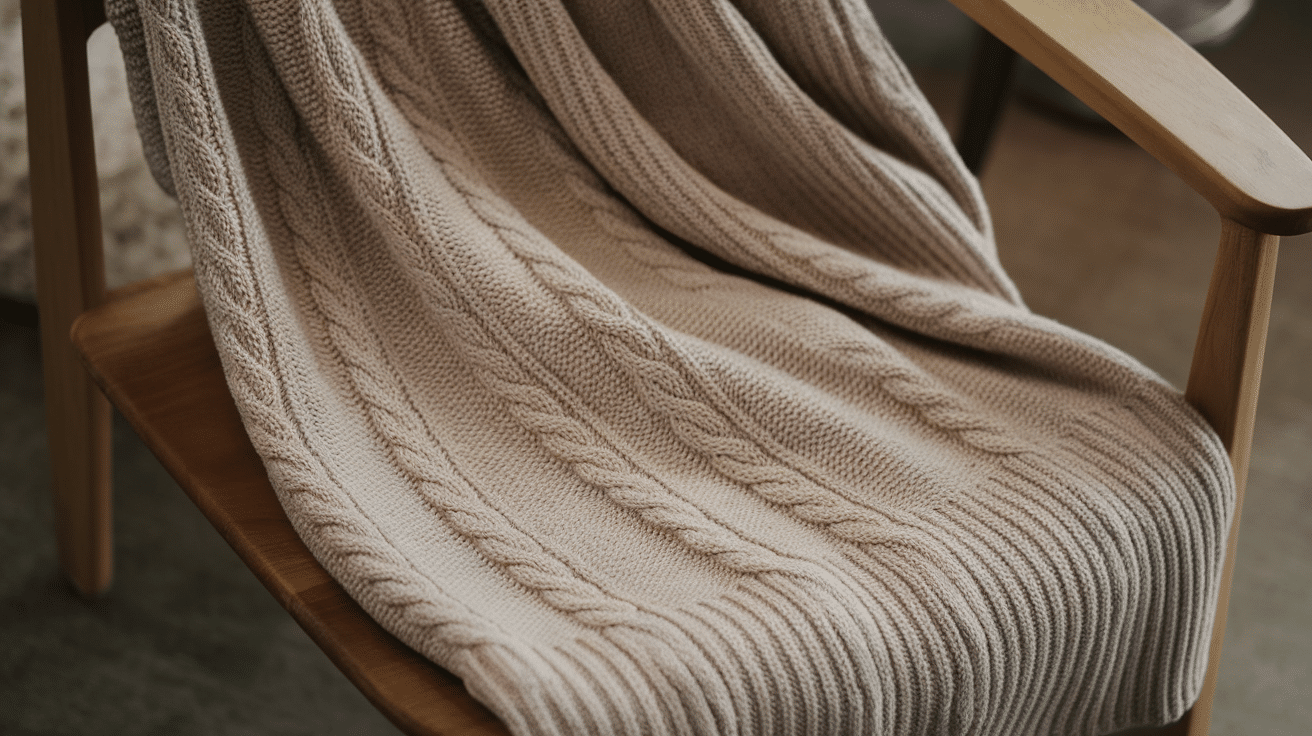
Cable knitting is a classic technique that adds beautiful, intricate designs to any blanket. A plain knit throw with cables is a great way to practice cables while creating a cozy, textured blanket.
Pattern Details
- Cast-on: 120 stitches.
- Instructions: Knit the blanket in a plain stitch, incorporating simple cable patterns every 10 rows for visual interest.
- Ideal For: Knitters looking to learn how to incorporate cables into their projects.
- Why It Works: The cables add texture and depth to the blanket, making it look more complicated than it is.
A plain knit throw with cables offers a great balance between simplicity and elegance. It’s perfect for knitters who want to try adding texture to their blankets.
23. Knitted Patchwork Blanket
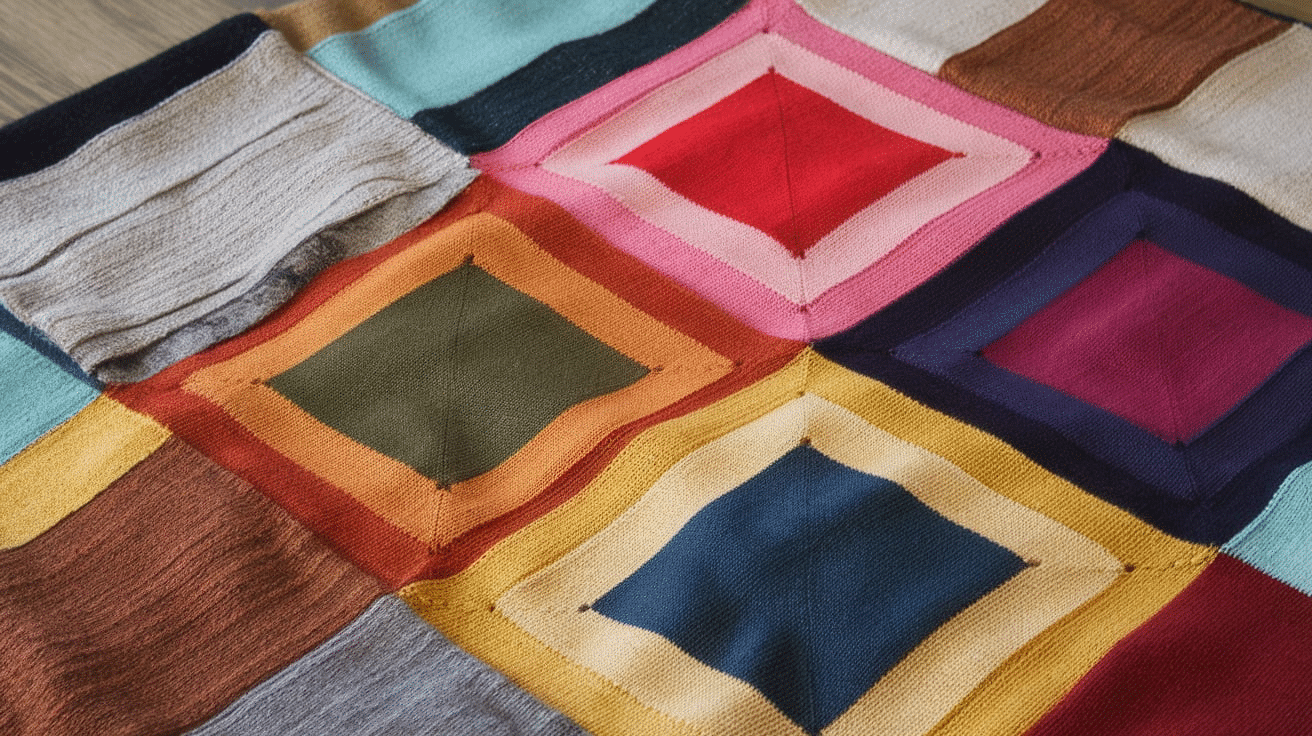
A patchwork blanket allows you to experiment with different designs and color combinations. Each patch is knitted separately, making this blanket perfect for using up leftover yarn.
Pattern Details
- Cast-on: Cast on for each patch individually (varies based on patch size).
- Instructions: Knit several small squares or rectangles in different patterns. Once finished, sew them together to form a blanket.
- Ideal For: Knitters who have leftover yarn and want to experiment with different patterns.
- Why It Works: The patchwork design lets you mix and match different patterns and colors, making it a unique and customizable project.
A knitted patchwork blanket is perfect for using up extra yarn and creating something unique. It’s a fun and creative project that offers plenty of opportunities for customization.
Helpful Tips for Knitting a Blanket
Knitting a blanket can be an enjoyable and relaxing experience, but it can also feel overwhelming at times. With the right tips, you can make the process smoother and more enjoyable. Here are some helpful tips to ensure your blanket turns out just the way you want.
1. Choose the Right Yarn: Choose a yarn that is comfortable, soft, and easy to care for. Worsted-weight yarn is a popular choice for blankets because it’s sturdy and provides the right amount of warmth.
2. Start Small: If you’re new to knitting, start with a smaller project, like a lap blanket, before tackling a larger one. This will help you get comfortable with the technique and size.
3. Keep Your Tension Consistent: Consistent tension is key to making sure your blanket is even. If you’re having trouble, take a break and try not to knit too tightly or too loosely.
4. Use a Needle Size That Works for You: Choose needles that are comfortable in your hands. Larger needles are great for a looser, cozier fabric, while smaller needles make a denser fabric.
5. Try a Simple Pattern: If you’re a beginner, stick to simple stitch patterns like garter stitch or stockinette. These patterns are easy to follow and still look beautiful.
6. Work in Sections: If a large blanket seems intimidating, try breaking it down into smaller sections. You can knit smaller panels and then sew them together later.
By following these tips, you can make knitting your blanket a more enjoyable and manageable experience.
Conclusion
Knitting your own blanket is a fulfilling and rewarding experience. Not only do you get to create a beautiful, functional piece of art, but you also enjoy the calming process of knitting each stitch. Whether you choose a simple garter stitch or a more intricate pattern, the process allows for creativity and customization.
You can select the perfect yarn, colors, and textures to match your personal style or the theme of the room. Plus, a handmade blanket makes a thoughtful gift with sentimental value.
By following these tips and patterns, you’ll be on your way to making the perfect blanket, whether it’s for cozy nights on the couch or as a special gift. Remember, knitting takes patience, but the final product is always worth the effort.
Frequently Asked Questions
How long does it take to knit a blanket?
The time it takes to knit a blanket depends on the pattern, yarn, and needle size. A simple blanket with bulky yarn can take a few days or weeks, while larger, more intricate patterns can take longer.
Do I need to use special needles for a blanket?
You don’t need special needles, but larger needles (such as size 8 to 10) work well for blankets because they make the project go faster and give the blanket a nice, loose texture.
Can I knit a blanket without seams?
Yes! You can knit a blanket in the round using circular needles or knit it in one large piece without needing to sew seams. This method is simple and leaves you with a seamless, cozy blanket.









